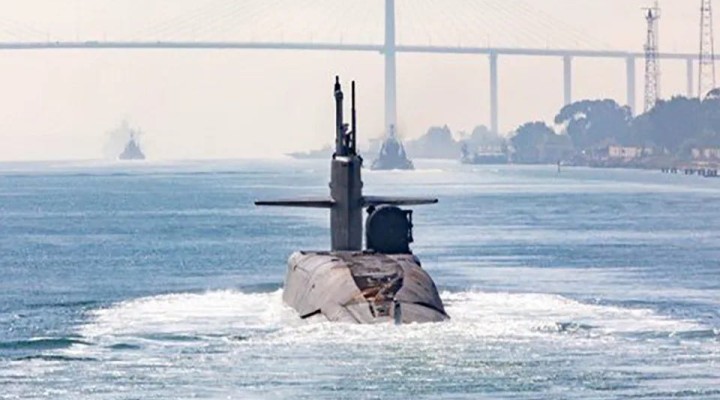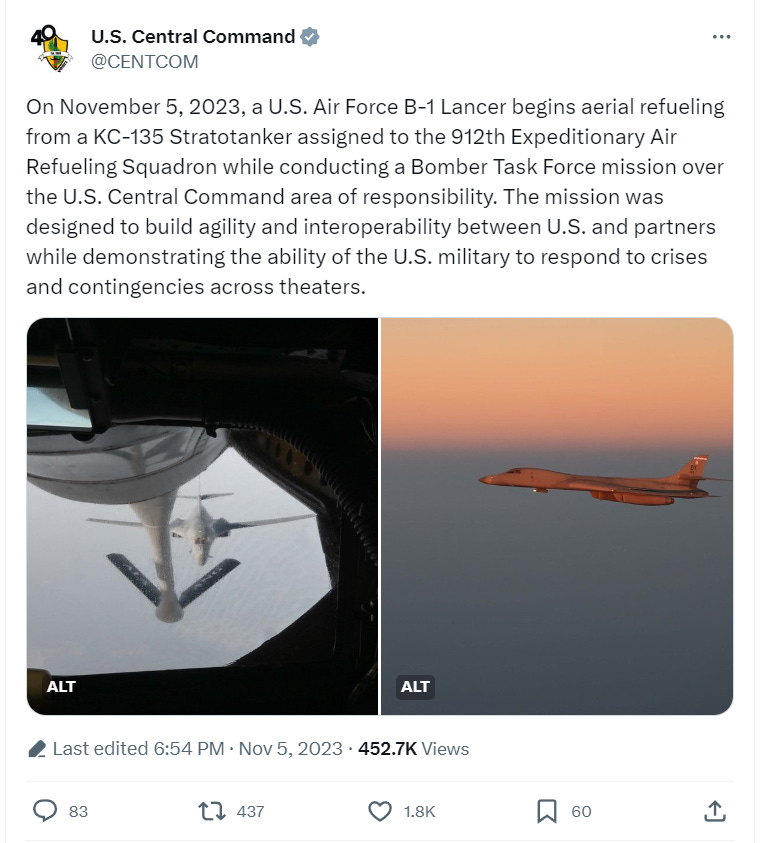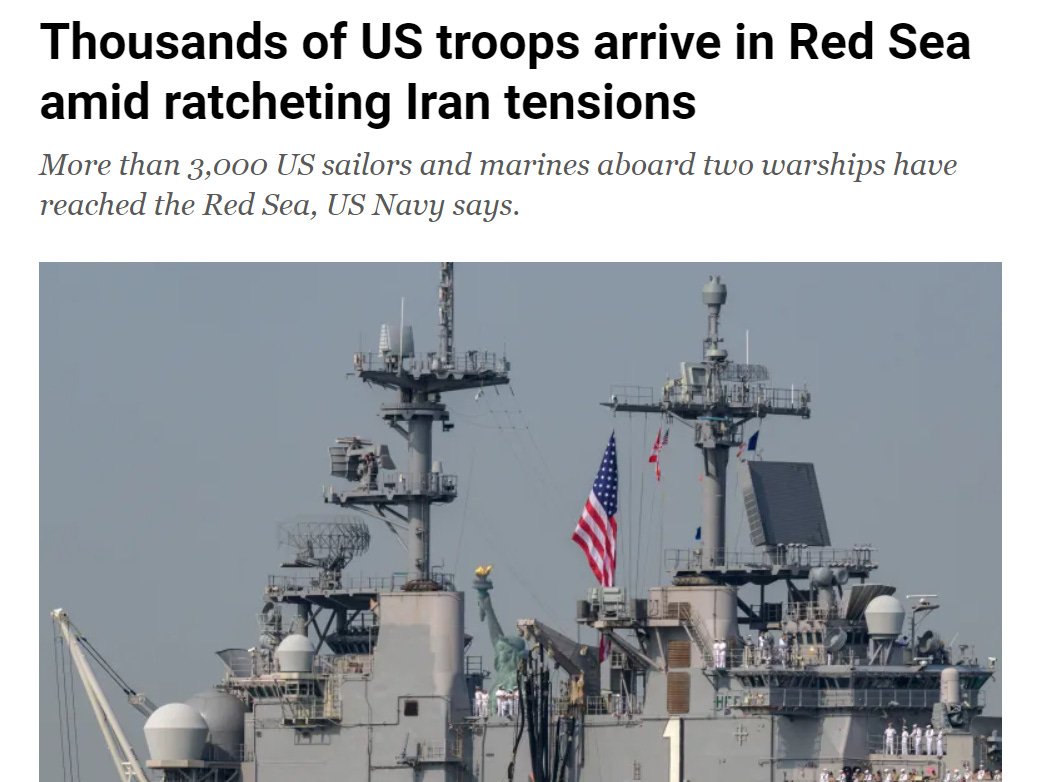US Naval build up in Red Sea is a ‘threat’ to Yemen and Iran

US is protecting its Zionist military outpost in Middle East with a show of strength in the Red Sea
A picture shared by US Central Command appears to show a guided missile submarine in the Suez Canal passing under the Al Salam Bridge northeast of Cairo.
US Central command has announced on social media that an Ohio-class submarine was entering its area of responsibility. A picture posted with the announcement appeared to show the sub in the Suez Canal northeast of Cairo.
The name of the submarine was not disclosed. However, the US Navy has four Ohio-class guided missile submarines (SSGNs) which are ‘former ballistic missile subs converted to fire Tomahawk cruise missiles rather than nuclear-tipped ballistic missiles”. The following quote is from a CNN article:
Each SSGN can carry 154 Tomahawk cruise missiles, 50% more than US guided-missile destroyers pack and almost four times what the US Navy’s newest attack subs are armed with.
Each Tomahawk can carry up to a 1,000-pound high-explosive warhead.
“SSGNs can deliver a lot of firepower very rapidly,” said Carl Schuster, a former director of operations at the US Pacific Command’s Joint Intelligence Center told CNN in 2021.
In March 2011, the SSGN USS Florida fired almost 100 Tomahawk missiles against targets in Libya. The attack was the first time the SSGNs were used in combat. The missiles effectively crippled Libyan air defence capability giving free rein, under a ‘No Fly Zone’ to NATO war planes to begin pulverising Libya and inhibiting President Muammar Gaddafi’s airforce response to the NATO direct and proxy aggression.
US military rarely announce the movements of their fleet of ballistic and guided missile subs. The nuclear-powered vessels operate almost always in secret. This is an indication the the US wants to use the arrival of the sub as a deterrent to the allies of Palestine in the region, particularly Yemen that has militarily intervened in defence of Palestinian Resistance in Gaza and the West Bank.
CNN – ‘In April, the Navy announced that the USS Florida, one of the two East Coast-based SSGNs, was operating in the Middle East. In June, the Navy publicized the visit of one of its two West Coast-based SSGN’s, USS Michigan, to South Korea as a show of US commitment to its Indo-Pacific allies.’
The X post follows a whistlestop tour of West Asian allies by Anthony Blinken – Israel, Turkey, Iraq, West Bank, Jordan and Cyprus.
On Sunday, Defense Secretary Lloyd Austin spoke with his Israeli counterpart, Minister of Defense Yoav Gallant. The primary reassurance was that the US was committed to deterring ‘any state or non-state actor seeking to escalate this conflict’.
Many would assume he was referring to Iran and Hezbollah – followed by Syria and Iraqi Resistance factions that have been targeting US bases in Syria and Iraq on a daily basis since October 7th.
The submarine crossed the Suez Canal and is believed to be heading towards the Red Sea to join the Eisenhower Carrier Strike Group which has also recently crossed the Suez Canal.

This Naval build-up includes the US KC-135 Stratotanker heading West also towards the Red Sea.
The KC-135 Stratotanker provides the core aerial refueling capability for the United States Air Force and has excelled in this role for more than 60 years. This unique asset enhances the Air Force’s capability to accomplish its primary mission of global reach. It also provides aerial refueling support to Air Force, Navy, Marine Corps and allied nation aircraft. The KC-135 is also capable of transporting litter and ambulatory patients using patient support pallets during aeromedical evacuations.
While this is being deceptively portrayed as a preemptive ‘defensive’ measure, it must be speculated that the US is preparing to directly engage with the Yemeni Resistance forces and National Salvation government on behalf of Israel to eliminate the threat to Israel from Yemeni ballistic missiles and drones. It also brings the US fleet into dangerous waters of potential direct conflict with Iran.
Remember the headlines in August 2023?

For those who are misled by the Western media deliberate omission of context around the term ‘Houthis’ which intends to marginalise the role played by a Resistance-aligned coalition movement in Yemen, here is a good summary from a commentator on the X platform.
“Seeing a lot of people confused by these news. “These are Houthis, not the Yemeni government” some people screech. You’re wrong. Here’s a quick crash course on some background history, the political landscape in Yemen & appropriate terminology:
1. The “Houthis” (known officially as the Ansarallah) is a broad grassroots movement with only a few defined political keypoints. This is deliberate, as the movement seeks to incorporate and represent the Yemeni people in its entirety across both Islamic and political differences. The movement has a right-wing, a centre-wing and a left-wing, each organized into separate unions and interest groups. For example, the left-wing is organized into what is called the “Cultural Front Against the Aggression”, just to be very specific.
2. The “Houthis” ceased being a rebel group in late 2014 with the advent of the September 21st Revolution and the signing of the UN-sponsored Peace & National Partnership Agreement.
Prior to 2014, the group could indeed be described as a rebel movement as it fought 6 consecutive wars against the corrupt Saudi-backed government of Ali Abdullah Saleh. In September 2014, when the “Houthis” entered Sana’a to topple said government, more than 2/3rds of the entire Yemeni Armed Forces switched and took their side instead of the side of the government, giving the “Houthis” access to missile stockpiles and heavy weapons. More on that further down.
3. There are currently two competing governments in Yemen, one based in the constitutional capital Sana’a, and one de-facto based in Aden – although the Aden-based government remains unable to exercise its authority there. The “internationally-recognized government” based in Aden doesn’t actually operate from within Yemen, but from a shadow cabinet based in the luxurious Ritz Carlton hotel in Riyadh where they’ve been exiled since February 2015.
Their direct authority is limited to warlord figures and tribal factions doing their bidding, representing less than 15% of Yemen’s total population. In turn, the so-called “Houthi rebels” are part of what is called the Government of National Salvation, which exercises direct authority over 85% of Yemen’s entire population.
4. The forces which have launched drones, ballistic & cruise missiles towards Israel are the forces aligned with the Government of National Salvation. They are far from being a “rag-tag rebel group”, but operates as a truly conventional army. They don’t “represent” the “Houthis”, nor do they wage war on behalf of one party or group against another. They represent all of Yemen, and fight on behalf of all of Yemen without exception. They are the only Armed Force in Yemen loyal to a government with a parliamentary mandate to exercise authority – a mandate the Saudi-backed “government” does not have.
It was indeed the Yemeni Armed Forces which launched the attacks against Israel.
“But aren’t they Iran-backed”?
Sure. Nobody is denying this. But the assistance Iran has been giving the “Houthis” does not even compare with the assistance it has given to Iraqi groups or even Hezbollah. Iranian assistance to the “Houthis” has thus far been limited to technical assistance and political support, such as recognizing the Government of National Salvation as the legitimate government of Yemen and opening a Yemeni embassy in Tehran.
On the technical aspect, the Iranian government has supplied the “Houthis” with blueprints for missiles and drones, as well as technical expertise for assembly and design. All missiles that the “Houthis” currently possess are manufactured locally inside Yemen based on the technical assistance supplied by Iran.
There has been a concerted effort by the US, UK, Saudi Arabia and the UAE to amplify the “Iran-backed rebels” narrative in hopes of stripping the “Houthis” of their national and local agency. In reality, the whole deal is beyond overblown, and senior policy experts with knowledge on Yemen have long agreed that the narrative doesn’t really correspond to reality.
https://beeley.substack.com/p/us-naval-build-up-in-red-sea-is-a
 TheAltWorld
TheAltWorld 
0 thoughts on “US Naval build up in Red Sea is a ‘threat’ to Yemen and Iran”